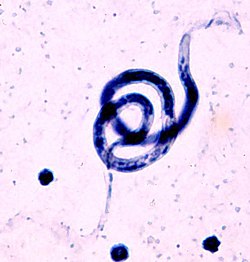Brugia malayi

Editor-In-Chief: Prab R Tumpati, MD
Obesity, Sleep & Internal medicine
Founder, WikiMD Wellnesspedia &
W8MD medical weight loss NYC and sleep center NYC
| Brugia malayi | |
|---|---|

| |
| Synonyms | |
| Pronounce | N/A |
| Specialty | N/A |
| Symptoms | Lymphedema, elephantiasis, fever, chills |
| Complications | |
| Onset | |
| Duration | |
| Types | |
| Causes | Parasitic infection by Brugia malayi |
| Risks | |
| Diagnosis | Microscopic examination, serology |
| Differential diagnosis | |
| Prevention | Mosquito control, preventive chemotherapy |
| Treatment | Anthelmintic medications such as diethylcarbamazine |
| Medication | |
| Prognosis | |
| Frequency | Endemic in parts of Asia |
| Deaths | |

Brugia malayi is a parasitic worm belonging to the family Filarioidea, which is a type of roundworm (nematode). It is one of the causative agents of lymphatic filariasis, a disease that is a major cause of lymphedema and elephantiasis in humans, primarily affecting populations in Southeast Asia and the Pacific Islands. The disease is transmitted to humans through the bite of an infected mosquito, making it a vector-borne disease.
Life Cycle[edit]
The life cycle of Brugia malayi involves two hosts: humans, where the adult worms reside, and mosquitoes, which act as vectors. The cycle begins when an infected mosquito bites a human, transferring the larvae, known as microfilariae, into the bloodstream. These microfilariae mature into adult worms within the human lymphatic system. Adult worms can live for several years, during which time female worms release thousands of microfilariae into the blood. When a mosquito bites an infected human, it ingests the microfilariae, which then mature into infective larvae within the mosquito. These larvae are then transmitted to another human host when the mosquito feeds again, completing the cycle.
Symptoms and Diagnosis[edit]
In the early stages of infection, individuals may be asymptomatic or present with mild symptoms such as fever and localized swelling. As the disease progresses, more severe symptoms can develop, including significant lymphedema, leading to the characteristic swelling and thickening of the skin known as elephantiasis. Diagnosis is typically made through the detection of microfilariae in a blood sample, although this can be challenging due to the nocturnal periodicity of the microfilariae, which are most abundant in the blood at night. Advanced diagnostic methods include imaging techniques such as ultrasound and the use of serological tests.
Treatment and Prevention[edit]
Treatment of lymphatic filariasis caused by Brugia malayi involves the use of antiparasitic medications, such as diethylcarbamazine (DEC), ivermectin, and albendazole, which can reduce the level of microfilariae in the blood. Preventive measures focus on controlling the mosquito population and preventing bites through the use of insecticide-treated bed nets, insect repellents, and community-wide administration of antiparasitic drugs to reduce transmission.
Epidemiology[edit]
Brugia malayi is endemic to parts of Asia and the Pacific Islands. The World Health Organization (WHO) has targeted lymphatic filariasis for elimination as a public health problem. Efforts to control the disease include mass drug administration (MDA) programs, aimed at reducing the reservoir of infection within human populations.
Research[edit]
Ongoing research into Brugia malayi includes the development of new diagnostic tools, vaccines, and treatments. The genome of Brugia malayi has been sequenced, providing insights into the biology of the worm and its interaction with both human hosts and mosquito vectors. This research is crucial for the development of novel strategies to combat lymphatic filariasis.
Ad. Transform your life with W8MD's Budget GLP-1 injections from $75


W8MD offers a medical weight loss program to lose weight in Philadelphia. Our physician-supervised medical weight loss provides:
- Weight loss injections in NYC (generic and brand names):
- Zepbound / Mounjaro, Wegovy / Ozempic, Saxenda
- Most insurances accepted or discounted self-pay rates. We will obtain insurance prior authorizations if needed.
- Generic GLP1 weight loss injections from $75 for the starting dose.
- Also offer prescription weight loss medications including Phentermine, Qsymia, Diethylpropion, Contrave etc.
NYC weight loss doctor appointmentsNYC weight loss doctor appointments
Start your NYC weight loss journey today at our NYC medical weight loss and Philadelphia medical weight loss clinics.
- Call 718-946-5500 to lose weight in NYC or for medical weight loss in Philadelphia 215-676-2334.
- Tags:NYC medical weight loss, Philadelphia lose weight Zepbound NYC, Budget GLP1 weight loss injections, Wegovy Philadelphia, Wegovy NYC, Philadelphia medical weight loss, Brookly weight loss and Wegovy NYC
|
WikiMD's Wellness Encyclopedia |
| Let Food Be Thy Medicine Medicine Thy Food - Hippocrates |
Medical Disclaimer: WikiMD is not a substitute for professional medical advice. The information on WikiMD is provided as an information resource only, may be incorrect, outdated or misleading, and is not to be used or relied on for any diagnostic or treatment purposes. Please consult your health care provider before making any healthcare decisions or for guidance about a specific medical condition. WikiMD expressly disclaims responsibility, and shall have no liability, for any damages, loss, injury, or liability whatsoever suffered as a result of your reliance on the information contained in this site. By visiting this site you agree to the foregoing terms and conditions, which may from time to time be changed or supplemented by WikiMD. If you do not agree to the foregoing terms and conditions, you should not enter or use this site. See full disclaimer.
Credits:Most images are courtesy of Wikimedia commons, and templates, categories Wikipedia, licensed under CC BY SA or similar.
Translate this page: - East Asian
中文,
日本,
한국어,
South Asian
हिन्दी,
தமிழ்,
తెలుగు,
Urdu,
ಕನ್ನಡ,
Southeast Asian
Indonesian,
Vietnamese,
Thai,
မြန်မာဘာသာ,
বাংলা
European
español,
Deutsch,
français,
Greek,
português do Brasil,
polski,
română,
русский,
Nederlands,
norsk,
svenska,
suomi,
Italian
Middle Eastern & African
عربى,
Turkish,
Persian,
Hebrew,
Afrikaans,
isiZulu,
Kiswahili,
Other
Bulgarian,
Hungarian,
Czech,
Swedish,
മലയാളം,
मराठी,
ਪੰਜਾਬੀ,
ગુજરાતી,
Portuguese,
Ukrainian
